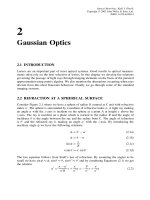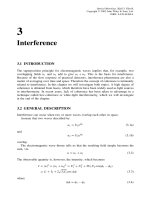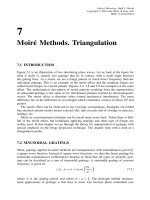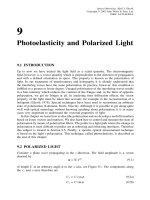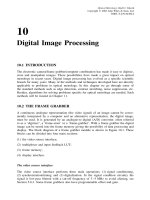Đo lường quang học P1
Bạn đang xem bản rút gọn của tài liệu. Xem và tải ngay bản đầy đủ của tài liệu tại đây (161.88 KB, 14 trang )
1
Basics
1.1 INTRODUCTION
Before entering into the different techniques of optical metrology some basic terms and
definitions have to be established. Optical metrology is about light and therefore we must
develop a mathematical description of waves and wave propagation, introducing important
terms like wavelength, phase, phase fronts, rays, etc. The treatment is kept as simple as
possible, without going into complicated electromagnetic theory.
1.2 WAVE MOTION. THE ELECTROMAGNETIC
SPECTRUM
Figure 1.1 shows a snapshot of a harmonic wave that propagates in the z-direction. The
disturbance ψ(z,t) is given as
ψ(z,t) = U cos
2π
z
λ
− νt
+ δ
(1.1)
The argument of the cosine function is termed the phase and δ the phase constant. Other
parameters involved are
U = the amplitude
λ = the wavelength
ν = the frequency (the number of waves per unit time)
k = 2π/λ the wave number
The relation between the frequency and the wavelength is given by
λν = v(1.2)
where
v = the wave velocity
ψ(z,t) might represent the field in an electromagnetic wave for which we have
v = c = 3 × 10
8
m/s
Optical Metrology. Kjell J. G
˚
asvik
Copyright
2002 John Wiley & Sons, Ltd.
ISBN: 0-470-84300-4
2
BASICS
z
y(
z
,
t
)
dl/2p
l
U
Figure 1.1 Harmonic wave
Table 1.1 The electromagnetic spectrum (From Young (1968))
The ratio of the speed c of an electromagnetic wave in vacuum to the speed v in a medium
is known as the absolute index of refraction n of that medium
n =
c
v
(1.3)
The electromagnetic spectrum is given in Table 1.1.
THE PLANE WAVE. LIGHT RAYS
3
Although it does not really affect our argument, we shall mainly be concerned with
visible light where
λ = 400–700 nm (1 nm = 10
−9
m)
ν = (4.3–7.5) × 10
14
Hz
1.3 THE PLANE WAVE. LIGHT RAYS
Electromagnetic waves are not two dimensional as in Figure 1.1, but rather three-dimen-
sional waves. The simplest example of such waves is given in Figure 1.2 where a plane
wave that propagates in the direction of the k-vector is sketched. Points of equal phase
lie on parallel planes that are perpendicular to the propagation direction. Such planes are
called phase planes or phase fronts. In the figure, only some of the infinite number of
phase planes are drawn. Ideally, they should also have infinite extent.
Equation (1.1) describes a plane wave that propagates in the z-direction. (z = constant
gives equal phase for all x, y, i.e. planes that are normal to the z-direction.) In the general
case where a plane wave propagates in the direction of a unit vector n, the expression
describing the field at an arbitrary point with radius vector r = (x,y,z) is given by
ψ(x, y,z, t) = U cos[kn · r − 2πνt + δ] (1.4)
That the scalar product fulfilling the condition n · r = constant describes a plane which
is perpendicular to n is shown in the two-dimensional case in Figure 1.3. That this is
correct also in the three-dimensional case is easily proved.
0
y(
r
)
+
U
−
U
l
y = 0
y = 0
y = 0
y =
U
y = −
U
y =
U
k
k
Figure 1.2 The plane wave
4
BASICS
y
r
q
n
x
n
.
r = r cos q = const
Figure 1.3
Wavefront
Rays
Figure 1.4
Next we give the definition of light rays. They are directed lines that are everywhere
perpendicular to the phase planes. This is illustrated in Figure 1.4 where the cross-section
of a rather complicated wavefront is sketched and where some of the light rays perpen-
dicular to the wavefront are drawn.
1.4 PHASE DIFFERENCE
Let us for a moment turn back to the plane wave described by Equation (1.1). At two
points z
1
and z
2
along the propagation direction, the phases are φ
1
= kz
1
− 2πνt + δ and
φ
2
= kz
2
− 2πνt + δ respectively, and the phase difference
φ = φ
1
− φ
2
= k(z
1
− z
2
)(1.5)
Hence, we see that the phase difference between two points along the propagation direction
of a plane wave is equal to the geometrical path-length difference multiplied by the wave
number. This is generally true for any light ray. When the light passes a medium different
from air (vacuum), we have to multiply by the refractive index n of the medium, such that
optical path length = n × (geometrical path length)
phase difference = k × (optical path length)
OBLIQUE INCIDENCE OF A PLANE WAVE
5
1.5 COMPLEX NOTATION. COMPLEX AMPLITUDE
The expression in Equation (1.4) can be written in complex form as
ψ(x, y, z, t) = Re{U e
i(φ−2πvt)
} (1.6a)
where
φ = kn · r + δ(1.6b)
is the spatial dependent phase. In Appendix A, some simple arithmetic rules for complex
numbers are given.
In the description of wave phenomena, the notation of Equation (1.6) is commonly
adopted and ‘Re’ is omitted because it is silently understood that the field is described
by the real part.
One advantage of such complex representation of the field is that the spatial and
temporal parts factorize:
ψ(x, y, z, t) = U e
i(φ−2πνt)
= U e
iφ
e
−i2πvt
(1.7)
In optical metrology (and in other branches of optics) one is most often interested in
the spatial distribution of the field. Since the temporal-dependent part is known for each
frequency component, we therefore can omit the factor e
−i2πvt
and only consider the
spatial complex amplitude
u = U e
iφ
(1.8)
This expression describes not only a plane wave, but a general three-dimensional wave
where both the amplitude U and the phase φ may be functions of x, y and z.
Figure 1.5(a, b) shows examples of a cylindrical wave and a spherical wave, while in
Figure 1.5(c) a more complicated wavefront resulting from reflection from a rough surface
is sketched. Note that far away from the point source in Figure 1.5(b), the spherical
wave is nearly a plane wave over a small area. A point source at infinity, represents a
plane wave.
1.6 OBLIQUE INCIDENCE OF A PLANE WAVE
In optics, one is often interested in the amplitude and phase distribution of a wave over
fixed planes in space. Let us consider the simple case sketched in Figure 1.6 where a
plane wave falls obliquely on to a plane parallel to the xy-plane a distance z from it. The
wave propagates along the unit vector n which is lying in the xz-plane (defined as the
plane of incidence) and makes an angle θ to the z-axis. The components of the n-and
r-vectors are therefore
n = (sin θ,0, cos θ)
r = (x, y, z)

